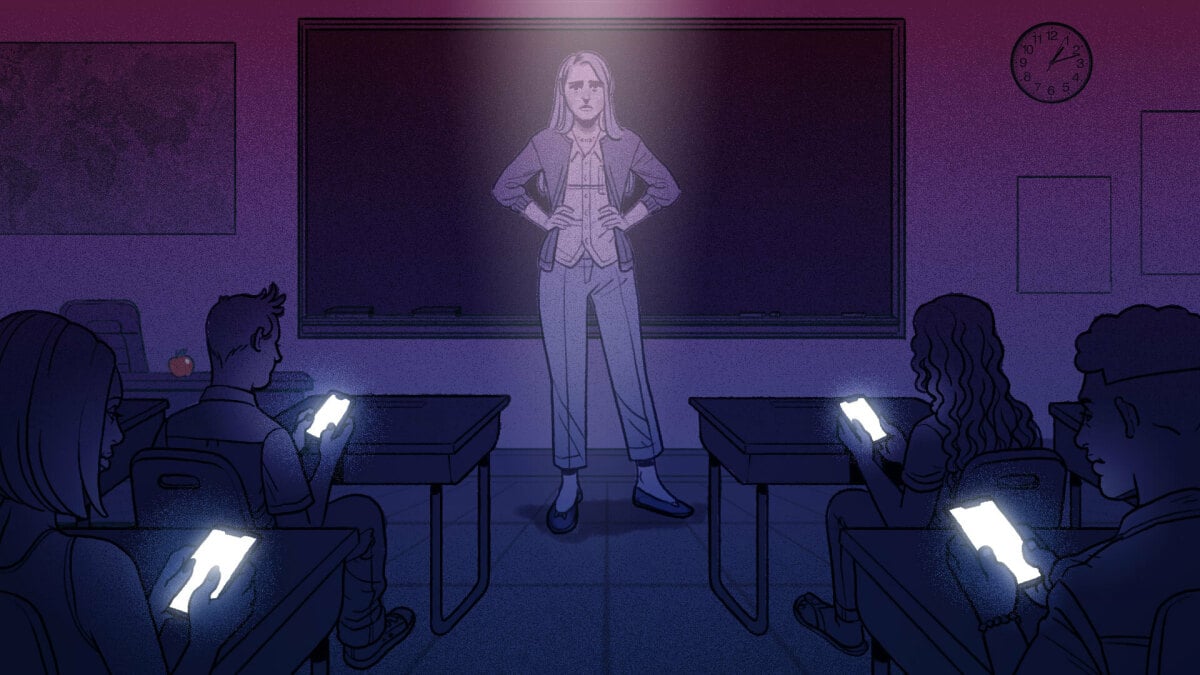Entertainment
Teacher burnout: The cost of social media in the classroom

For the past two decades, New York City school teacher Sari Beth Rosenberg has guided high school students through the annals of U.S. history.
Rosenberg’s generation-spanning vantage point gives her rare insight into their education. She can tell you what happened, at least in her experience, when nearly every teen started showing up to school with an internet-connected device and one or more social media accounts.
Rosenberg noticed the shift about a decade ago. Her students’ attention span seemed shorter, and the teens became more prone to distraction. Conflicts over being excluded or bullied via social media became routine. Students brought that tension into the classroom and hallways. Rosenberg noticed, through observation and conversation, how social media wore down her students’ mental health.
The pandemic supercharged all of that, says Rosenberg. Devices became a lifeline, not only for school but for social connection. The rise of TikTok has further diminished their appetite for long-form content, she notes. While students once welcomed watching a documentary, they’re now less excited by the prospect. Rosenberg adapted her curriculum accordingly, focusing on short video content with high production values.
These tectonic shifts in classroom behavior and expectations have taken their own toll on Rosenberg. Managing the devices, the students’ ability to focus, and the complex emotions attached to phone and social media use has contributed to, at times, feeling burnt out and demoralized.
“It’s completely exhausting,” says Rosenberg, of trying to help students succeed in school under these circumstances.
Rosenberg ranks the issue among the top factors contributing to teacher burnout in her educator community. She recognizes, however, that teachers may feel differently in districts across the country where conservative attacks on classroom curriculum and instruction are common.
Nevertheless, social media in the classroom can feel like an intractable, draining problem for teachers. It’s not something they have the tools to solve, even though it requires constant management on their part. Solutions range from demanding the social media businesses fundamentally change the product they offer youth to leveraging the positive aspects of social media to boost classroom participation.
The cost of social media in the classroom
Rosenberg isn’t the only teacher who feels like this role isn’t one she expected to play when she became an educator.
This summer, the American Federation of Teachers (AFT), a union representing 1.7 million educators, including Rosenberg, co-published a report detailing how social media has helped sow “dramatic disruption” in American schools.
The examples included “swatting” hoaxes that send law enforcement to campuses and “viral challenges” that involve damaging school property. The everyday cost includes diverting school resources away from educating students and into increasing disciplinary services and personnel to handle the “explosion of bullying and harassment incidents” that happen on social media.
Teachers also find themselves acting like untrained social workers or therapists as they try to help students navigate worsening depression, anxiety, and self-harm that students describe as related to their negative experiences on social media.
For more Social Good stories in your inbox, sign up for Mashable’s Top Stories newsletter today.
A survey conducted in 2022 by the National Education Association found that 55 percent of the union’s educators were considering leaving the profession. The Educator Confidence Report, an annual survey produced by the education technology company HMH and research firm MarketCast, recently found that overall confidence in the teaching profession increased slightly compared to the previous year.
Though factors like low pay, testing pressures, and the threat of gun violence in schools contribute to teacher burnout, social media is uniquely out of teachers’ hands; they can’t bargain new contracts that fundamentally reshape how students’ digital habits influence their classrooms.
The AFT report calls on social media businesses to do what educators cannot: Stop designing platforms with addictive features that ensnare young users and expose them to potentially harmful content.
The report’s recommendations urge the businesses to remove illegal content, eliminate autoplay and infinite scroll, default young users’ accounts to the strictest privacy settings, stop the targeted marketing of minors, cease the use of algorithms that “push harmful and traumatic” material to students, and end the use of push notifications during the school day.
“The student is then opting out emotionally, mentally, and socially from the classroom.”
Randi Weingarten, president of AFT, says headline-grabbing news, like a swatting hoax, shows the extreme impact of social media on schools. But the more insidious issue, she notes, is that social media robs students of focus, sometimes quite literally. Weingarten has toured schools where students’ eyes are locked on their phones, scrolling during a lesson.
She knows they’re finding “nourishment” on their devices, which makes it doubly hard to take them away.
“The student is then opting out emotionally, mentally, and socially from the classroom,” she says. “The teacher doesn’t have the resources either to compete with it or to actually help the student. That’s the burnout factor.”
Weingarten doesn’t think it’s realistic to take devices away from students, since they use school-issued technology to learn. It also isn’t feasible for districts to uniformly revoke access to WiFi or other cellular connections, particularly because both parents and students may want that access in the event of an emergency situation.
What social media businesses are doing to make platforms safer
Social media businesses have a varied track record of responding to concerns like the ones AFT and its partners, which include the American Psychological Association and the nonprofit organization ParentsTogether, have raised.
Last year, AFT sent a petition and letter to Meta, the parent company of Instagram and Facebook, requesting that it meaningfully address gossip accounts that bully schoolchildren, and never received a response. A handful of school districts have attempted to hold social media businesses accountable for their perceived role in the adolescent and teen mental health crisis by suing them.
Mashable asked TikTok, Snap, and Meta, the parent company of Facebook, Instagram, and Threads, to comment on AFT’s report and its recommendations.
A spokesperson for Meta noted that the company had already implemented a version of many of AFT’s recommendations. New Instagram accounts for teens 16 and younger, for example, are set to private. Those users are also automatically configured to a “less” setting on the platform, which limits the sensitive content they’ll see when navigating Explore, Search, and Reels. Teens who were already on Instagram prior to this policy change receive prompts to change their settings to “less” if still set to “standard.”
A spokesperson for TikTok highlighted the platform’s Family Pairing feature, which was introduced in March. The tool allows parents to link their own account to their teen’s in order to implement screen time limits, notification muting, and keyword filtering. Though TikTok doesn’t silence notifications during the school day by default, accounts for users between the ages of 13 and 15 don’t receive push notifications from 9 p.m. onward, while notifications for 16- and 17-year-olds are automatically disabled starting at 10 p.m.
According to Snap, the Snapchat platform already defaults the accounts of 13- to 17-year-olds to the strictest privacy settings, doesn’t open directly to a feed of content that could promote endless scrolling, and employs advanced detection technologies to proactively find illegal content.
Other measures introduced this year include policies designed to reduce youth screen time, strengthen default safety settings for teen users, and limit exposure to inappropriate content.
In late August, AFT and its partners sent several major social media businesses, including Meta, Snap, and TikTok, a letter urging them to take action on the report’s recommendations. AFT told Mashable that it received general positive responses from some of them, but noted that it had wanted to see a sustained commitment to fundamentally redesigning their platforms to ensure youth safety and well-being.
“This is about having reasonable accountability where we prioritize the protection of children and their safety over profits,” says Weingarten.
How teachers can reclaim their role
Rosenberg agrees that social media businesses must change how platforms are designed in order to protect both students and educators.
Yet she also tries to embrace social media. Her own Instagram account, where she often shares a liberal take on current events and politics, has more than 24,300 followers. (Rosenberg is also the cofounder of Teachers Unify to End Gun Violence, a nonprofit coalition which has its own social media presence.)
Familiar with some of social media’s most appealing features, Rosenberg tries to replicate them in her classroom, while also helping students develop the skills to use their devices and accounts in ways that benefit them.
Lately, Rosenberg has opted to teach in a mini-lesson format, not unlike what students might encounter on TikTok or YouTube Shorts.
Francie Alexander, senior vice president of research at HMH and a former teacher, says incorporating popular elements of the online experience can be a very effective strategy.
Certain HMH software products, like Waggle, for example, feature gamification, immediate feedback, avatars, progress monitoring, and short bursts of engagement to sustain student interest and attention. Alexander says that giving kids agency to choose how they engage in classroom activities helps as well, since the online experience revolves around feeling like they’re in control of what information to pursue.
Though this requires some degree of labor, particularly if a teacher doesn’t use social media, these proactive steps can help teachers feel like they’ve reclaimed some control, says Alexander.
The tactic has benefited Rosenberg, though she admits that it’s time-intensive. Ultimately, she says the emotional and mental strain on teachers managing this problem won’t lessen until the technology driving it changes.
“We are not going to be able to eliminate phones,” says Robertson. “But I really hope that the social media businesses get the pressure just across the board to do something because teachers have enough to deal with in the classroom.”
Topics
Social Good
Social Media
-

 Business6 days ago
Business6 days agoTikTok Shop expands its secondhand luxury fashion offering to the UK
-

 Business5 days ago
Business5 days agoUnitedHealth says Change hackers stole health data on ‘substantial proportion of people in America’
-

 Business6 days ago
Business6 days agoMood.camera is an iOS app that feels like using a retro analog camera
-

 Business4 days ago
Business4 days agoTesla’s new growth plan is centered around mysterious cheaper models
-

 Business3 days ago
Business3 days agoXaira, an AI drug discovery startup, launches with a massive $1B, says it’s ‘ready’ to start developing drugs
-

 Business5 days ago
Business5 days agoTwo widow founders launch DayNew, a social platform for people dealing with grief and trauma
-

 Business4 days ago
Business4 days agoUK probes Amazon and Microsoft over AI partnerships with Mistral, Anthropic, and Inflection
-

 Entertainment4 days ago
Entertainment4 days agoTesla’s in trouble. Is Elon Musk the problem?




























